


Every entity listed in site prefs has an expandable Permissions section that allows you to see and edit permissions for that entity. Every entity in ShotGrid has four types of permissions: who can see it, who can create it, who can retire it, and who can edit it.Įntity Permissions from Site Prefs. Clicking this loads in all the permissions-by permission role, for that particular entity type-handy when you want to see and edit permissions when dealing directly with an entity. In the entities section of site preferences, you'll notice a 'Permissions' section. Example: Editing permissions on an entity If any checkbox in the permission tab is greyed out, this means that the field is either uneditable, or there's a conditional (advanced) permission rule on the field, and can't be edited through the UI. This is good to quickly view or adjust permissions on individual fields, and can be done on any grid page. Just right-click on the column header of the field (in list mode), select the "Configure field." option, then click the Permissions tab in the dialog that appears, make your changes, and click 'Update field'.

Every field in ShotGrid has two types of permissions on it: who can see the field and who can edit the field.Īnyone who can edit fields has access to the configure field dialog. This is the most common case for ongoing permission tweaking, so we'll start here. Choose "Edit Selected", and then choose the permission role to apply to everyone in one go. You can also select multiple People, and right-click anywhere in the permission group field on a record. Each person’s account record has a permissions group field where you can change their permission group, and therefore what changes they’re able to make in ShotGrid.ĭouble-click into the field to choose the right permission role for each Person. To see or modify which permission group a person is in, go to the People page. You can see and edit permissions on individual fields or entities themselves, or in the Permissions area of the Admin menu (for those with permission!). If you need to reset to the vendor defaults (see feature request here), please contact support, but it is recommended to make a copy of your vendor group should you want to edit it. You currently cannot reset a group to the default vendor permissions in the UI. Doing this will not reset anything without also clicking 'Save changes' Click to expand a particular role (e.g., Artist).You can easily find out exactly what your stored default permissions are by following these instructions. This saves a lot of time in setting up brand new permission roles.įinding out what the default permissions are Default permissions will be set for the new permission role based on the template you choose. You’ll need to give the new permission role a name, and choose a Template.Click the “+ New Permission Role” button in the upper right of the permissions page.Notes if they (or a group that they are in) are in the To or CC field, or if they created the Note, and Shots and Assets if they (or a group that they are in) are assigned to a Task on that Shot or Asset, Tasks that they (or a group that they are in) are assigned, Vendors can only see Projects that they are specifically assigned to. There are no conditional permissions present on the manager default group.

Managers share most functionality with Admins but have certain entities restricted by default. Versions, Time Logs, and Tickets if they are the creator of those entities. Status fields on Tasks they are assigned to, though they can’t edit other Task fields, Notes if they are the author of that Note, Permissions are controlled by 'permission roles' one person is assigned to one role.ĭefault roles that ship with ShotGrid are: AdminĪdmins have complete control over all operations in ShotGrid (the only exceptions here include modifying things that are required by the system, such as deleting the Template Project).Īrtists can only see Projects that they are specifically assigned to. ShotGrid provides advanced permissions to control who can see and do what throughout the system. Permission overview and advanced permissions.Example: Editing permissions on a personal page.Example: Editing permissions on an entity.Example: Editing permissions on a field.Finding out what the default permissions are.


 0 kommentar(er)
0 kommentar(er)
